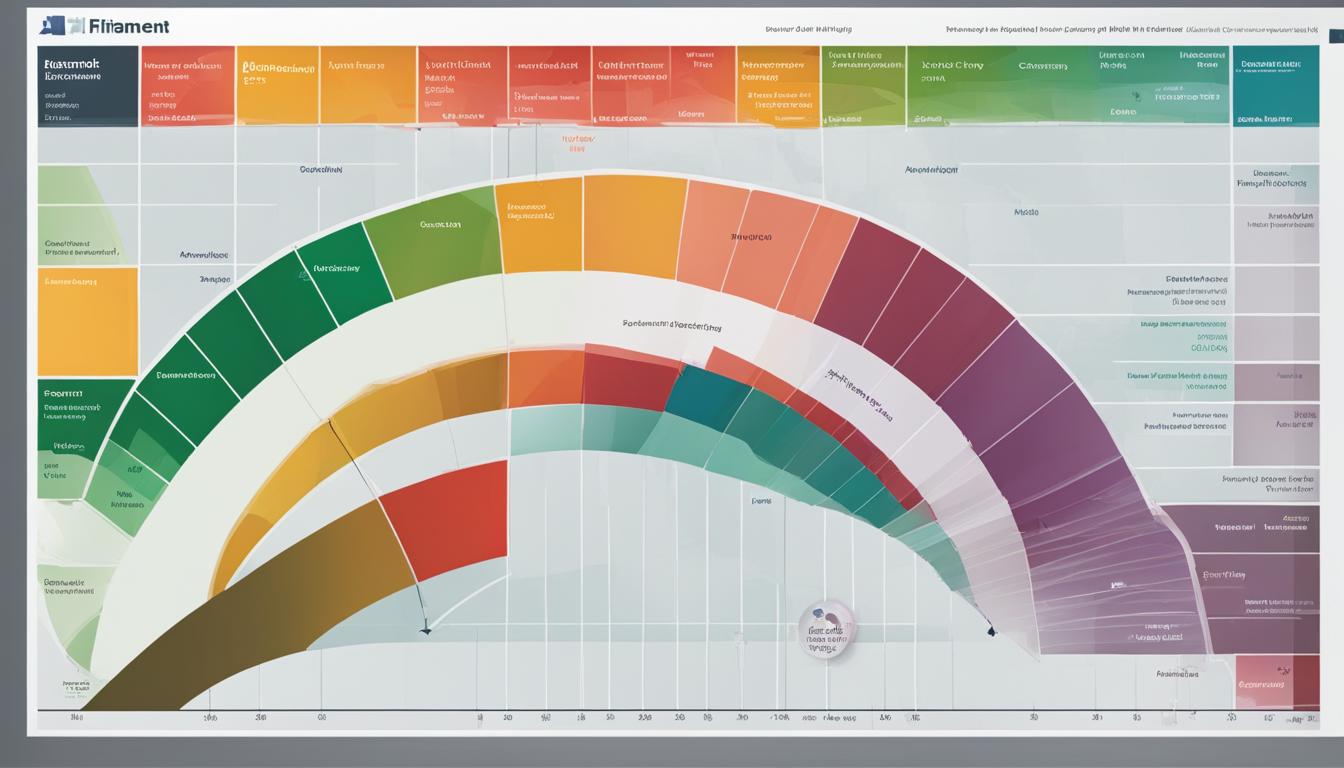Social media platforms have become a breeding ground for overspending and accumulating debt. The rise of buy now, pay later (BNPL) services offered by companies like Klarna and Afterpay has made it easier than ever for consumers to make purchases without having to pay the full amount upfront. According to a poll by LendingTree, 43% of Americans have used a BNPL service, and these services are particularly popular among women, Gen Z, and those with a yearly income between $50,000 and $74,999.
However, the ease of these services can lead to impulse buying and overspending, especially for college students and recent graduates who may have limited financial literacy. It is important for consumers to carefully consider their financial situation and the reasons for taking on debt before using BNPL apps.
Key Takeaways:
- Social media platforms have contributed to overspending and debt accumulation.
- Buy now, pay later services make it easier for consumers to make purchases without upfront payment.
- 43% of Americans have used a BNPL service, with women, Gen Z, and those with a yearly income between $50,000 and $74,999 being the most frequent users.
- Impulse buying and a lack of financial literacy can lead to overspending.
- Consumers should carefully consider their financial situation before using BNPL apps.
Understanding the Risks of BNPL Loans
Before using a BNPL service, it is crucial for consumers to understand the risks involved. Careful consideration of personal finances should be done to ensure that the loan will not create a burden that cannot be repaid. Consumers should ask themselves if the purchase is necessary and if BNPL is the only option for affording it. It is also important to review the payment terms and be sure that the payments can be made on time. Late payments on BNPL loans can come with fees and may impact a consumer’s spending limit. These late payments can also be reported to credit bureaus, potentially damaging a consumer’s credit score. With the increasing use of BNPL loans, credit reporting agencies like Experian and TransUnion are starting to include BNPL loan data in credit scores, making it even more important for consumers to manage their debt responsibly.
By understanding the risks associated with BNPL loans, consumers can make informed decisions about their financial health and avoid pitfalls that can lead to excessive debt. Late payments and negative credit reporting can have long-term consequences, limiting access to credit and hindering financial growth. It is essential for individuals to assess their financial situation, budget effectively, and only use BNPL loans when absolutely necessary. Responsible borrowing and prompt repayment are crucial to maintaining financial stability and a healthy credit score.
Hidden Risks of BNPL Loans
While BNPL loans may seem convenient and appealing, they come with hidden risks that consumers need to be aware of. These risks can include:
- Hidden fees: BNPL services may charge additional fees, such as late payment fees, transaction fees, or service fees. These fees can add up quickly and increase the overall cost of the purchase.
- Impact on credit score: Late or missed payments on BNPL loans can negatively impact a consumer’s credit score. This can have long-term effects on their ability to obtain credit in the future.
- Overborrowing: The ease of BNPL loans can lead to overborrowing and accumulating more debt than originally intended. Consumers should carefully assess their financial situation and only borrow what they can afford to repay.
By understanding these risks and being proactive in managing debt, consumers can make more informed decisions about using BNPL services and avoid unnecessary financial stress.
Table: Comparing BNPL Loan Providers
| BNPL Provider | Interest Rate | Payment Terms | Penalties for Late Payments |
|---|---|---|---|
| Klarna | Varies | Flexible | Late fees and potential impact on credit score |
| Afterpay | No interest | 4 equal installments | Late fees and potential impact on credit score |
| Quadpay | No interest | 4 equal installments | Late fees and potential impact on credit score |
It is important for consumers to compare different BNPL loan providers before making a decision. The table above provides a brief overview of some popular BNPL providers, but it is important for individuals to research and understand the specific terms and conditions of each provider before using their services.
The Temptations of Overspending Through BNPL
One of the biggest risks of BNPL loans is the temptation to overspend. Social media platforms like TikTok and Instagram contribute to this temptation by promoting fast fashion and other trends. Influencers and marketing campaigns show consumers how much they can buy now and pay for later, creating a sense of urgency and entitlement. This constant exposure to promotional content, combined with easy access to BNPL loans, can lead to impulsive buying and overspending.
Many consumers who use BNPL loans admit to overspending, as it allows them to purchase things they previously couldn’t afford. However, this approach is not financially responsible and can lead to a cycle of debt. It is important for consumers to be mindful of their spending habits and to resist the pressures of social media marketing.
To illustrate the impact of social media on spending habits, we can look at the rise of fast fashion as a trend promoted on these platforms. Fast fashion brands like Zara and H&M constantly release new collections, tempting consumers to constantly update their wardrobes with the latest trends. This encourages excessive buying and a culture of disposable fashion, leading to wasteful spending and contributing to the negative environmental impact of the fashion industry.
Fast Fashion Consumption Comparison
| Category | Percentage Increase in Consumption |
|---|---|
| Apparel & Accessories | 56% |
| Footwear | 48% |
| Beauty & Personal Care | 37% |
| Electronics | 22% |
| Furniture & Home Decor | 16% |
In the words of fashion icon Coco Chanel, “Fashion fades, only style remains the same.” In today’s fast-paced social media-driven world, it is important for consumers to remember that style is timeless, but trends are fleeting. By resisting the temptations of overspending and being more mindful of our spending habits, we can make wiser choices that align with our long-term financial goals.
By understanding the temptations of overspending and the influence of social media marketing, consumers can take control of their financial well-being. It is crucial to establish a healthy balance between enjoying the benefits of BNPL loans and maintaining responsible spending habits. With a strategic approach to managing finances, individuals can avoid falling into the trap of excessive debt and work towards a more secure financial future.
The Financial Struggles of Generation Z
Generation Z, the cohort born between 1997 and 2012, faces unique financial challenges that can have a significant impact on their credit scores and overall financial well-being. These challenges include higher borrowing costs, slowing wage growth, student loans, and other debts that make it difficult for young adults to maintain a strong financial standing.
A study conducted by the Transamerica Center for Retirement Studies revealed that while 29% of Generation Z respondents reported improved financial circumstances during the pandemic, these gains are being eroded as wage increases slow and the temporary pause on student loan payments comes to an end. This combination of factors leaves many young adults struggling to keep up with their financial obligations, often leading to a negative impact on their credit scores.
In addition to these challenges, limited credit history and high borrowing costs also contribute to lower credit scores among Generation Z individuals. Their limited credit history makes it harder for them to qualify for favorable lending terms, such as lower interest rates, which can further hinder their ability to manage debt effectively.
Table: Generation Z Financial Challenges
| Challenges | Impact |
|---|---|
| Higher borrowing costs | Difficulties in securing favorable lending terms |
| Slowing wage growth | Inability to keep up with increasing living expenses |
| Student loans | Added burden of debt repayment |
| Other debts | Financial strain and potential difficulty meeting obligations |
These financial struggles faced by Generation Z individuals can restrict their ability to achieve important milestones such as purchasing a home or a car, saving for retirement, or even starting a business. It is crucial for young adults to be proactive in managing their finances, seeking financial education and guidance to overcome these hurdles and improve their financial stability.
Avoiding Unnecessary Spending
When it comes to managing finances, cutting back on unnecessary spending can have a significant impact on one’s financial well-being. By making conscious decisions and avoiding certain financial pitfalls, individuals can improve their financial situation and work towards their goals.
1. Review and eliminate unnecessary insurance policies
One area where individuals can potentially save money is by reviewing their insurance policies. Some insurance policies may not be necessary or may provide coverage that is already included in other policies. For example, identity theft insurance or children’s life insurance may not be essential for everyone. By eliminating unnecessary policies, individuals can reduce their monthly expenses and save money in the long run.
2. Strategically consider refinancing options
Refinancing a home can be a great way to save money on mortgage payments, but it’s important to approach it strategically. Analyze the potential benefits and calculate the associated costs, such as loan fees and closing costs. By carefully assessing the refinancing options available, individuals can make informed decisions that align with their financial goals.
3. Avoid making only minimum credit card payments
Making only the minimum payment on credit card bills can result in high interest charges and a never-ending cycle of debt. It is crucial to pay more than the minimum amount due whenever possible. By paying off credit card debt as quickly as possible, individuals can minimize interest charges and improve their financial standing.
4. Control emotional spending
Emotional spending, also known as “retail therapy,” can wreak havoc on a budget. It’s important to recognize triggers and find alternative ways to cope with emotions or stress. Instead of making impulsive purchases, consider allocating funds for specific budgeted items or engaging in activities that bring joy without a hefty price tag.
5. Cancel unused memberships and subscriptions
Many individuals accumulate monthly or annual memberships and subscriptions that they no longer use or need. Take the time to review all current memberships and subscriptions and determine whether they are truly providing value. By canceling unused or unnecessary subscriptions, individuals can free up funds for more important financial priorities.
6. Plan ahead and resist convenience purchases
Convenience purchases, such as grabbing coffee or ordering takeout frequently, can add up over time. Planning meals, carrying a reusable water bottle, and brewing coffee at home can help save money in the long run. By resisting the temptation of convenience purchases, individuals can make significant strides towards their financial goals.

By implementing these strategies and being mindful of unnecessary spending, individuals can take control of their finances and work towards a more secure financial future.
The Pitfalls of Trying to Keep Up
Trying to keep up with others and living beyond one’s means is a common way people waste money. The pressure to buy certain things to gain status can lead to overspending and accumulating debt. It’s important to remember that everyone’s financial goals are different, and comparing oneself to others can hinder personal financial progress. Instead of focusing on what others have, individuals should stay true to their own lifestyle and budget.
Building wealth, buying a home, and saving for retirement require individualized financial planning and should not be influenced by the spending habits of others.
“Comparison is the thief of joy.” – Theodore Roosevelt
Constantly trying to keep up with the Joneses can lead to unnecessary financial stress and strain on one’s budget. It’s essential to prioritize personal financial goals and make spending decisions based on one’s financial situation and values. This allows individuals to stay focused on their own progress and maintain a healthy financial well-being.
Comparing on Social Media
Social media platforms often contribute to the temptation of trying to keep up with others. The curated images and posts on platforms like Instagram and Facebook can create a distorted view of reality, making it seem like everyone is living a luxurious lifestyle. However, it’s important to remember that social media presents an idealized version of people’s lives and does not accurately reflect their financial situation.
It’s crucial to be mindful of the influence of social media and to resist the urge to make financial decisions based on what others are doing. Instead, focus on individual financial goals and take steps towards achieving them at a pace that aligns with personal circumstances.

The Link Between Social Media and Debt
The rise of social media has revolutionized the way we connect, share, and shop. However, alongside the convenience and endless possibilities, there is a darker side to the digital world: the link between social media and debt. Online shopping has become a go-to activity for many, with the ability to browse and purchase products with just a few clicks. And with the advent of buy now, pay later services, such as Klarna and Afterpay, it has never been easier to make those impulse purchases without considering the long-term financial consequences.
Overspending is a common pitfall when it comes to online shopping and social media. The constant exposure to trendy products, influencers flaunting their latest purchases, and targeted advertisements create a sense of urgency and FOMO (fear of missing out). It’s easy to get caught up in the excitement and make purchases that may not align with our financial goals or needs. Before we know it, we find ourselves drowning in debt and struggling to keep up with the payments.
That’s why financial awareness is crucial in today’s digital age. We must be mindful of our spending habits and develop a sense of financial responsibility. It’s essential to ask ourselves whether a purchase is truly necessary or if it’s just a temporary desire fueled by social media influences. By understanding the risks associated with online shopping and buy now, pay later services, we can make more informed decisions and avoid falling into the trap of unnecessary debt.
Being financially aware also means being proactive about our financial health. We can take steps to limit our exposure to tempting advertisements, such as unfollowing certain accounts or setting up ad blockers. Additionally, prioritizing financial education and seeking guidance from experts can provide valuable insights and strategies for managing our finances. With the right knowledge and awareness, we can break free from the cycle of overspending and create a more secure financial future.
FAQ
What are the risks of using buy now, pay later (BNPL) loans?
The risks of using BNPL loans include the potential for hidden fees, late payment fees, and the impact on your credit score. It is important to carefully review the payment terms and ensure that you can make payments on time to avoid additional costs and potential damage to your credit.
How can social media contribute to overspending through BNPL loans?
Social media platforms often promote trends and fast fashion, creating a sense of urgency and entitlement to buy now and pay later. Influencers and marketing campaigns can impact consumers’ spending habits, leading to impulsive buying and overspending through BNPL services.
What financial challenges do Generation Z face?
Generation Z faces challenges such as high borrowing costs, student loans, limited credit history, and slowing wage growth. These factors can impact their credit scores and overall financial stability, making it more difficult for them to access larger loans or achieve their financial goals.
How can individuals avoid unnecessary spending?
Individuals can avoid unnecessary spending by carefully evaluating insurance policies, refinancing strategically, avoiding minimum credit card payments, controlling emotional spending, canceling unused memberships and subscriptions, and planning ahead to avoid convenience purchases.
Why is it important to resist the pressure of trying to keep up with others?
Each individual has different financial goals, and comparing oneself to others can hinder personal financial progress. Building wealth, buying a home, and saving for retirement require individualized financial planning and should not be influenced by the spending habits of others.
How does social media contribute to the link between overspending and debt?
Social media platforms, combined with the availability of BNPL services, create an environment that promotes overspending and accumulating debt. The allure of online shopping, combined with the ease of making purchases through BNPL loans, leads many consumers to overspend and experience financial stress.
Can Economic Behavior on Social Media Lead to Overspending?
Decoding economic behavior through social media is an emerging area of study. It is believed that overspending can be influenced by the constant exposure to online shopping and advertisements on social media platforms. The ease of purchasing and the pressure to keep up with trends can lead individuals to spend more than they could afford, ultimately jeopardizing their financial well-being. Understanding how economic behavior is influenced by social media can help individuals make informed decisions and avoid falling into the trap of overspending.





One response to “Double Tap Into Debt: How Social Media Can Lead to Overspending!”
[…] higher interest rates, and a lower credit score. It’s essential to monitor and control your social media and overspending habits to maintain a healthy financial […]